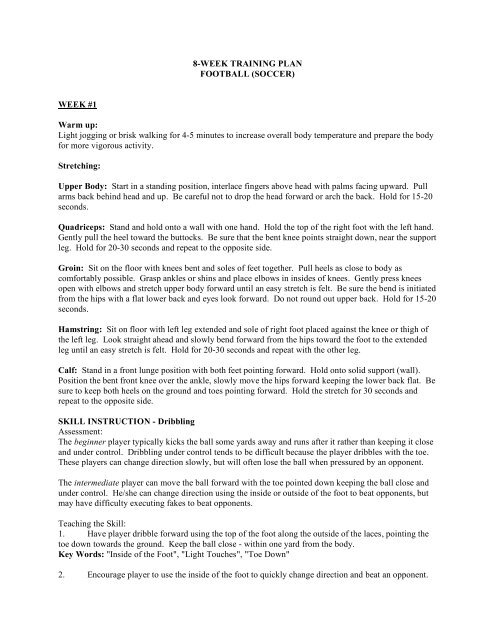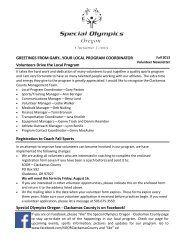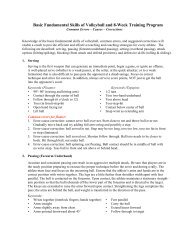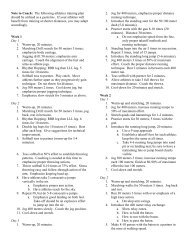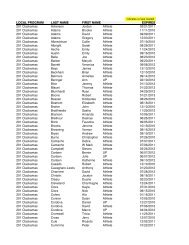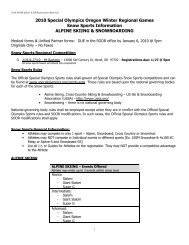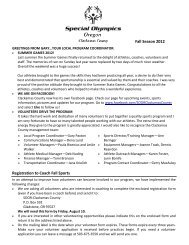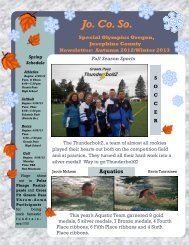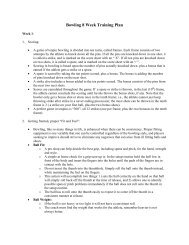8-WEEK TRAINING PLAN FOOTBALL (SOCCER) WEEK #1 Warm ...
8-WEEK TRAINING PLAN FOOTBALL (SOCCER) WEEK #1 Warm ...
8-WEEK TRAINING PLAN FOOTBALL (SOCCER) WEEK #1 Warm ...
Create successful ePaper yourself
Turn your PDF publications into a flip-book with our unique Google optimized e-Paper software.
8-<strong>WEEK</strong> <strong>TRAINING</strong> <strong>PLAN</strong><br />
<strong>FOOTBALL</strong> (<strong>SOCCER</strong>)<br />
<strong>WEEK</strong> <strong>#1</strong><br />
<strong>Warm</strong> up:<br />
Light jogging or brisk walking for 4-5 minutes to increase overall body temperature and prepare the body<br />
for more vigorous activity.<br />
Stretching:<br />
Upper Body: Start in a standing position, interlace fingers above head with palms facing upward. Pull<br />
arms back behind head and up. Be careful not to drop the head forward or arch the back. Hold for 15-20<br />
seconds.<br />
Quadriceps: Stand and hold onto a wall with one hand. Hold the top of the right foot with the left hand.<br />
Gently pull the heel toward the buttocks. Be sure that the bent knee points straight down, near the support<br />
leg. Hold for 20-30 seconds and repeat to the opposite side.<br />
Groin: Sit on the floor with knees bent and soles of feet together. Pull heels as close to body as<br />
comfortably possible. Grasp ankles or shins and place elbows in insides of knees. Gently press knees<br />
open with elbows and stretch upper body forward until an easy stretch is felt. Be sure the bend is initiated<br />
from the hips with a flat lower back and eyes look forward. Do not round out upper back. Hold for 15-20<br />
seconds.<br />
Hamstring: Sit on floor with left leg extended and sole of right foot placed against the knee or thigh of<br />
the left leg. Look straight ahead and slowly bend forward from the hips toward the foot to the extended<br />
leg until an easy stretch is felt. Hold for 20-30 seconds and repeat with the other leg.<br />
Calf: Stand in a front lunge position with both feet pointing forward. Hold onto solid support (wall).<br />
Position the bent front knee over the ankle, slowly move the hips forward keeping the lower back flat. Be<br />
sure to keep both heels on the ground and toes pointing forward. Hold the stretch for 30 seconds and<br />
repeat to the opposite side.<br />
SKILL INSTRUCTION - Dribbling<br />
Assessment:<br />
The beginner player typically kicks the ball some yards away and runs after it rather than keeping it close<br />
and under control. Dribbling under control tends to be difficult because the player dribbles with the toe.<br />
These players can change direction slowly, but will often lose the ball when pressured by an opponent.<br />
The intermediate player can move the ball forward with the toe pointed down keeping the ball close and<br />
under control. He/she can change direction using the inside or outside of the foot to beat opponents, but<br />
may have difficulty executing fakes to beat opponents.<br />
Teaching the Skill:<br />
1. Have player dribble forward using the top of the foot along the outside of the laces, pointing the<br />
toe down towards the ground. Keep the ball close - within one yard from the body.<br />
Key Words: "Inside of the Foot", "Light Touches", "Toe Down"<br />
2. Encourage player to use the inside of the foot to quickly change direction and beat an opponent.
Key Words: "Inside of the Foot", "Change Direction", "Chop across the ball"<br />
3. Encourage player to use outside of the foot to shield the ball from opponents and evade their<br />
tackles. Key Words: "Keep it on the Outside", "Spin Away"<br />
4. Teach players to use the sole of the foot to change direction with the ball. Key Words:<br />
"Reverse"<br />
COMPETITION DRILLS<br />
Dribble in the Square: Designate a 15 yard x 15 yard square. Every player has a soccer ball. Players<br />
dribble around inside the square avoiding collisions with other players. This can be used to introduce<br />
different dribbling techniques. Coach can play as a CHASER. Players must try to avoid being kicked out<br />
of the square. Play for 30 seconds. Award 1 point for keeping the ball safe.<br />
Immediate Attack: Play on a mini-field, as above, with goals 4 yards wide. Form 2 teams of 3 players,<br />
one being the goalkeeper. Play a regular game except that when a player gets ossession of the ball, he/she<br />
must immediately dribble against an opponent and try to get past him. A player cannot pass the ball until<br />
this is done. Award 1 point for successfully dribbling past an opponent and 3 points for each goal scored.<br />
COOL DOWN/TEAM TALK: Brisk walking and light stretching (as in warm up). Give<br />
encouragement for jobs well done and make suggestions regarding "homework". Make team<br />
announcements at this time.<br />
<strong>WEEK</strong> #2<br />
<strong>Warm</strong> up: As above in Week <strong>#1</strong><br />
Review last week's skill<br />
SKILL INSTRUCTION - Shooting<br />
Assessment:<br />
The beginner player is able to kick in the general direction of the goal but without any consistency or<br />
power. This player usually kicks the ball with the toe or awkwardly with the inside of the foot. He/she<br />
may slow down or stop before attempting to shoot and finds it very difficult to shoot a ball that is rolling<br />
across the body.<br />
The intermediate player has a positive attitude towards taking shots and is able to shoot with a reasonable<br />
degree of accuracy. This player is able to shoot with the top of the foot (instep) to generate power.<br />
He/she will occasionally connect successfully with a rolling ball but has learned to increase success by<br />
controlling the ball before shooting. The player is still likely to ose composure and effectiveness under<br />
pressure qand has not mastered the advanced skill of volleying the ball out of the air.<br />
Teaching the Skill:<br />
1. When shooting, approach the ball slightly from the side, not straight on. This allows the foot to<br />
make a more natural and effective strike on the ball. Key Words: "From the side", "Sweep<br />
Around"<br />
2. For good accuracy and power, keep the head down and strike the ball with the instep and with the<br />
ankle firmly locked. Key Words: "Head Down", "Toe Down", "Watch the Foot Strike"<br />
3. Make a strong impact on the ball and follow through with the foot. Key Word: "Strike"
COMPETITION DRILLS:<br />
Shoot Out: Use a regular goal or marker cones. Place a starting cone 15-20 yards from the goal. Three<br />
players on the "shooting team", three players on the "goalkeeping team". Shooter has 3 seconds to dribble<br />
and shoot. Coach counts down "3-2-1 shoot". Goalkeepers rotate after each shot. Five shots each, then<br />
change teams.<br />
1 vs. 1 to Goal!: Designate a 2 yard x 20 yard square with goals at opposite ends. Form two teams of 3<br />
players. Number equally matched players "1-2-3". Play <strong>#1</strong> from each team on the field with #2 in goal<br />
and #3 behind the goal as a chaser. Play 1 vs. 1 for 1 minute. Coach rolls in spare balls when needed. 1<br />
point for each shot on target and 3 points per goal. Rotate players. Keep the team score.<br />
COOL DOWN/TEAM TALK: Brisk walking and light stretching (as in warm up). Give<br />
encouragement for jobs well done and make suggestions regarding "homework". Make team<br />
announcements at this time.<br />
<strong>WEEK</strong> #3<br />
<strong>Warm</strong> up: As above in Week <strong>#1</strong><br />
Review last week's skill<br />
SKILL INSTRUCTION - Control (Receiving)<br />
Assessment:<br />
The beginner player usually reacts to a ball by kicking it rather than trying to control it. If the player does<br />
attempt to control the ball, it tends to bounce off the foot or leg and is usually recovered by another<br />
player.<br />
The intermediate player has the ability to get behind the flight of most balls that come within playing<br />
distance. He successfully brings a rolling ball under control using the inside of the foot and makes a good<br />
attempt at controlling airballs using the chest. While basic control is good, the player will often lose<br />
composure and the ball when pressured by opponents.<br />
Teaching the Skill:<br />
1. Use the inside of the foot to bring a ground ball under control. All the body weight should be<br />
on the supporting leg with the receiving foot raised slightly off the ground. Key Words:<br />
"Open out the Foot", "Raise the Foot"<br />
2. Relax and cusion the ball rather than offering resistance against the ball. Key Words: "Soft<br />
Foot", "Cushion"<br />
3. For airballs, relax the body as the ball hits the chest or thigh - depending on the height of the<br />
ball. "Give" with the ball rather than offering resistance. Key Words: "Relax", "Cushion"<br />
COMPETITION DRILLS:<br />
Control and Shoot: One coach per four players - set up a 4 yard x 2 yard goal. Place a starting cone 12<br />
yards out and a shooting cone 6-8 yards out. Coach rolls the ball out slowly to player who must control it<br />
then dribble and shoot within 3 seconds. Score 1 point per successful control/shot. Same player repeats<br />
three times then goes to back of line. With more mobile players, roll the ball slightly to one side and<br />
make the player move to get behind the ball, control it and shoot.
Control and Shoot with Chasers: Divide players into 3 teams: shooting team, defending team, and<br />
goalkeeping team. Set up a 4 yard x 2 yard goal, shooting cone at 15 yards, and a defender's cone at 20<br />
yards. Coach stands to the side of the goal and rolls out a ball to the shooter. Shooter controls the ball,<br />
then dribbles and shoots. As the shooter receives the ball, the defender is released and tries to chase and<br />
tackle the shooter. Shooter can shoot at any time. Goalkeepers must remain within 1 yards of the goal<br />
line. Players return to their group after the shot. Rotate groups after 5 minutes.<br />
Understanding the Game: Teach players about the basic aim and organization of the game through<br />
mini-soccer games. Progress from the simplest 1 vs 1 situations up to full games as players become more<br />
familiar with the basic principles and rules of play. Mini soccer games can become a part of every<br />
practice.<br />
ATTACK/DEFEND (1 vs. 1)<br />
Designate a 15 yard x 10 yard area with goals at each end. Form 2 teams of 3 wearing different colored<br />
scrimmage vests, and number the players 1-2-3 (no goalkeepers). Coach stands at the halfway line with<br />
several soccer balls. When a player's number is called, he comes out and plays for 30-45 seconds against<br />
opponent with the same number. Other players wait behind the goal and help collect balls and return<br />
them to the coach. If the ball goes out, the coach will immediately roll in another ball.<br />
Key questions to ask your players:<br />
-Which goal are you scoring in<br />
-Which goal are you defending<br />
What color shirt is your team wearing<br />
What color shirt is the other team wearing<br />
What do you do when you have the ball (ATTACK!)<br />
What do you do when the opponent has the ball (DEFEND!)<br />
COOL DOWN/TEAM TALK: Brisk walking and light stretching (as in warm up). Give<br />
encouragement for jobs well done and make suggestions regarding "homework". Make team<br />
announcements at this time.<br />
<strong>WEEK</strong> #4<br />
<strong>Warm</strong> up: As above in Week <strong>#1</strong><br />
Review last week's skill<br />
SKILL INSTRUCTION – Passing & Understanding the Game<br />
Assessment:<br />
The beginner tends to play with his head down, looking at the ball, and so is rarely able to look for a<br />
teammate before passing. He usually uses the toe or awkwardly tries to pass with the inside of the foot.<br />
A player at this level can kick successfully in the correct general direction, but rarely to a teammate.<br />
The intermediate player is able to locate and make eye contact with the intended receiver before passing.<br />
He uses the inside of the foot for short passes and the instep for longer passes. A player at this level still<br />
finds some passes difficult to master; i.e., outside of the foot, chipped, and 1-touch passes. A player at<br />
this level still finds some passes difficult to master; i.e., outside of the foot, chipped, and 1-touch passes.<br />
In addition, he is deliberate and predictable when passing in a game and will not disguise or fake passes.
Teaching the Skill:<br />
1. Make eye contact with the intended receiver. This is the starting point for successful passing.<br />
Key words: "Head up", "Look at your teammate"<br />
2. The inside of the foot can be used for short "push" passes. The ball should be struck firmly,<br />
with the foot following through in the direction of the intended receiver. Key words: "Push<br />
the ball firmly", "Follow through with your foot"<br />
3. The instep can be used to send longer passes. Key words: "Toe down", "Firm strike"<br />
COMPETITION DRILLS:<br />
Soccer Bowling: Designate a 10 yard x 10 yard square. Place 5-10 cones up the middle. Form teams of<br />
3-4 players. Players pass and try to knock down cones. Coach retrieves and returns balls from the<br />
middle. Keep time to see how long it takes to knock down all the cones, or play one group against<br />
another.<br />
3 vs. 1 Keep Away: Designate a 15 yard x 15 yard square. Position one player in the middle (start with<br />
the coach). 3 players stand on the outside of the square with the ball. See how many passes the 3 players<br />
can make before being intercepted. Rotate middle players every 2 minutes. Show players how to move<br />
to the open corner to get open for a pass. See which group can get the most passes.<br />
Understanding the Game:<br />
TEAMMATES (2 vs. 2)<br />
Designate a 20 yard x 10 yard field with 4 yard x 2 yard goals at each end. Form 4 teams of two. Two<br />
teams stand behind each goal. Coach stands at the halfway line with several soccer balls. Teams come<br />
out to play 2 vs. 2. If the ball goes out of play, leave it and receive another from the coach. If the<br />
defending player gains possession of the ball, he must pass the ball to a teammate before trying to score.<br />
For lower ability players, allow each team to dribble and pass from one goal to the other without any<br />
opposition. Introduce opponents later.<br />
Key questions to ask your players:<br />
Who is your teammate<br />
Who do you pass to<br />
Do you tackle your teammate (NO!)<br />
COOL DOWN/TEAM TALK: Brisk walking and light stretching (as in warm up). Give<br />
encouragement for jobs well done and make suggestions regarding "homework". Make team<br />
announcements at this time.<br />
<strong>WEEK</strong> #5<br />
<strong>Warm</strong> up: As above in Week <strong>#1</strong><br />
Review last week's skill<br />
SKILL INSTRUCTION - Heading<br />
Assessment:<br />
The beginner is sometimes fearful of the ball and will avoid contact. Players that do try to head the ball<br />
do so without looking at the ball, heading the ball with the top of the head rather than with the forehad.<br />
The result is inconsistent power and little accuracy.
The intermediate player shows no fear of attacking the ball with the head and is able to use good<br />
technique: keeps the eyes on the ball, and plays the ball with the forehead. He is able to get some power<br />
behind the ball by using the upper body and neck. The player will direct the ball in the correct general<br />
direction, but without fine accuracy. Most intermediate players will still find it difficult o jump and head<br />
a ball successfully.<br />
Teaching the Skill:<br />
1. Look at the ball as it comes towards the head and keep the eyes open as contact is made. Key<br />
words: "Eyes Open", "Watch the Ball"<br />
2. To get more power, rock onto the back foot before the ball arrives and get some leverage<br />
when heading. Key Words: "Rock Back"<br />
3. Make contact with the forehad, not with the top of the head, and attack through the ball for<br />
power. Key words: "Forehead", "Power Through"<br />
COMPETITION DRILLS:<br />
Head to the Coach: Designate a 15 yard x 15 yard square. Assign one coach per 3 players. Each coach<br />
has a soccer ball. Players jog around the coaches. Coach calls a player's name then gently tosses a ball to<br />
be headed back. One point for a successful header. To keep players thinking, introduce surprise<br />
commands like "freeze", "sit" and "all to the center", upon which players must react quickly or else lose a<br />
point.<br />
Head on Goal: Divide players into 2 teams of 3 players each: attacking team and goalkeeping team. Set<br />
up a 4 yard x 2 yard goal, and a marker cone at 12 yards in front of the goal. Coach stands to the side of<br />
the goal and throws a ball underhand to an oncoming attacker. Attacker attempts to head the ball and<br />
score. Goalkeepers must remain within 1 yard of the goal-line. Goalkeepers rotate after each shot.<br />
Repeat. Each player will get 3 attempts; then switch teams.<br />
COOL DOWN/TEAM TALK: Brisk walking and light stretching (as in warm up). Give<br />
encouragement for jobs well done and make suggestions regarding "homework". Make team<br />
announcements at this time.<br />
<strong>WEEK</strong> #6<br />
<strong>Warm</strong> up: As above in Week <strong>#1</strong><br />
Review last week's skill<br />
SKILL INSTRUCTION – Tackling and Understanding the Game<br />
Assessment:<br />
The beginner will usually chase the ball or an approaching opponent and make some kind of effort to kick<br />
the ball away. He is either tentative and may fear making tackles, or is somewhat "out of control" and<br />
make contact with just about everything except the ball!<br />
The intermediate player can successfully focus on, track, and close down opponents dribbling with the<br />
ball. He has the coordination to make good, strong contact on the ball using the inside of the foot.<br />
However, this player will often fall for fakes from the attacking player.<br />
Teaching the Skill:
1. When an opponent has the ball, move quickly to close the distance to that player. As you<br />
near the player, slow down, and concentrate. Focus attention on the ball, not on the<br />
opponent's body. Key words: "Go to the ball", "Don't let them Dribble"<br />
2. When you see an opportunity to get the ball, make a firm strike with the inside of the foot.<br />
Get your weight behind the tackle, do not reach in. Key words: "See your foot strike the<br />
ball"<br />
3. Be alert after you make contact. The ball will often run loose. Be ready to pursue it and gain<br />
possession. Counterattack quickly. Key words: "Make contact, then make it yours"<br />
Understanding the Game:<br />
FIELD POSITIONS / TEAM PLAY (3 vs. 3)<br />
Designate a 25 yard x 15 yard field with 4 yard x 2 yard goals. Form 2 teams of 3 without goalkeepers<br />
(you can also play this as 4 vs. 4 with a goalkeeper). Designate positions - right wing/left wing/center.<br />
Play a regular 3 vs. 3 game (use kick-ins for a ball over the sidelines). Coach how to play in each part of<br />
the field. Focus on the wing players. Occasionally call "freeze!" Players must stop and check their<br />
positions. Award points for good positional play.<br />
Key questions to ask your players:<br />
What position are you playing<br />
Where are the wings<br />
We don't crowd, we ____ (SPREAD OUT!)<br />
Great soccer players play as a _____ (TEAM!)<br />
<strong>WEEK</strong> #7<br />
<strong>Warm</strong> up: As above in Week <strong>#1</strong><br />
Review last week's skill<br />
SKILL INSTRUCTION - Goalkeeping<br />
Assessment:<br />
The beginner goalkeeper is effective only if the ball is played directly at him. This player often reacts to<br />
ground balls by kicking them away rather than using his hands. The player has limited ability to time an<br />
effective dive for shots going into the corners of the goal. Throwing the ball out to teammates may be<br />
inaccurate.<br />
The intermediate goalkeeper has a good awareness of the goal and of basic goalkeeping techniques and<br />
responsibilities. The player shows good lateral motion to get in a good position to take a shot and will<br />
usually attempt to get his hands to the ball. The player attempts to dive for ground shots, although these<br />
dives may be slow. This level of goalkeeper will generally not be able to dive for shots in the air or attack<br />
crosses in the air. He should be able to distribute the ball accurately to teammates.<br />
Teaching the Skill:<br />
A. Handling balls going straight at the goalkeeper:<br />
1. Goakeeping consists of occasional flurries of action and a lot of standing and waiting.<br />
Maintaining concentration when the ball is away from the goal is critical. Key<br />
words: "On your toes", "Watch the play"
2. As the ball approaches, the goalkeeper should be in the ready position, with hands up<br />
at about waist height. Key words: "Ready position:, "hands ups"<br />
3. If the ball is rolling along the ground, the goalkeeper must get behind the line of the<br />
ball and either a.) scoop the ball up with the legs straight and together or b.) go down<br />
on one knee and scoop the ball up. Key words: "Get behind the Ball", "Feet<br />
together, scoop", "One knee down, scoop"<br />
4. For a ball coming in the air, a goalkeeper should secure the ball with both hands. The<br />
2 hands need to work together as one unit. Key words: "Two hands", "Catch it --<br />
hug it"<br />
COMPETITION DRILLS:<br />
Fundamentals: Set up a triangle using large cones or flags, 4 yards/side. Position a goalkeeper on each<br />
side of the triangle. Coach stands in the middle with several balls. Go around the group working on basic<br />
goalkeeping fundamentals. Goalkeepers throw the ball back to the coach. Do the same , but throw the<br />
balls randomly to keep goalkeepers thinking and mentally alert.<br />
Goalie in the Middle: Mark out a central goal 4 yards x 2 yards (or full-size goal for 11 a side players)<br />
with flags or cones. Goalkeeper stands in the middle. Goalkeeper receives different kinds of shots (easy<br />
at first, then build up to hard shots). Goalkeeper takes a ball from one side, then quickly turns around and<br />
takes a shot from the other side. Count number of saves made before a goal is scored.<br />
COOL DOWN/TEAM TALK: Brisk walking and light stretching (as in warm up). Give<br />
encouragement for jobs well done and make suggestions regarding "homework". Make team<br />
announcements at this time.<br />
<strong>WEEK</strong> #8<br />
<strong>Warm</strong> up: As above in Week <strong>#1</strong><br />
Review last week's skill<br />
SKILL INSTRUCTION - Team Play (Understanding the Game)<br />
Scrimmage or Practice Game in preparation for upcoming tournaments<br />
COOL DOWN/TEAM TALK: Brisk walking and light stretching (as in warm up). Give<br />
encouragement for jobs well done and make suggestions regarding "homework". Make team<br />
announcements at this time.


